– Feature Article – Weight: Place it Carefully
– Car Showcase
– Memory – 90 Percent
– Q&A
Weight: Place it Carefully
Over the past few years I have written several articles, speed tips, and answers to questions that relate to weight position. Today, I’d like to bring this information together into one article. I realize that some of this information is a repeat, but I hope that each of you will find a few nuggets of information that you can put to good use.
Terms
First, let’s get some terms defined:
- COG: Center of gravity – the location at which an object balances in all three dimensions. In this article it will strictly refer to the lengthwise and height-wise point at which the car balances (also known as the horizontal COG and vertical COG).
- Weight Position: the location on the car where the added ballast weight is placed. Note that weight position affects, but is not the same as the COG,
- Wheelbase: the distance between the front and back axles.
Locating the COG
The horizontal COG of a pinewood derby car can be easily located as follows: (1) set a balance stand (or a ruler on its long edge) on a table and (2) lay the car (with wheels and axles in place) on the device as shown in Figure 1. Move the car forward or backward until it balances on the ruler. This point at which the car balances is the horizontal COG.
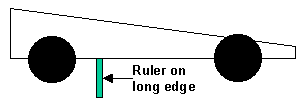 Figure 1 – Locating the COG
Figure 1 – Locating the COGDue to track differences there is no one best horizontal COG. In fact, the horizontal COG that produces best results on one track will likely not produce the best results on another track.
There are three track types in use today (see Figure 2), with type 2 being the most predominant:
- Continuous-slope – One continuous slope from the starting line to the finish line.
- Ramp-flat – Starts on a slope, then transitions to a long flat section.
- S-shaped – Starts on a slope, transitions to a steeper slope, and then transitions to a flat section).
 Figure 2 – Track Types
Figure 2 – Track TypesFor the ramp-flat track, best performance is obtained offsetting the horizontal COG towards the rear of the car. The actual location varies from track to track, but a good rule of thumb is 1 to 1-1/4 inches in front of the rear axle. This location should be adjusted based on the following track features:
- Length: longer tracks (over 40 feet) require a COG closer to the center of the car. Due to the offset COG, the rear wheels will bear more weight than the front wheels. On tracks with a long flat section, this extra rear friction will result in a faster speed loss.
- Smoothness: To maintain stability, rougher tracks require a COG closer to the center of the car.
Why is the horizontal COG offset to the rear on this type of track. With an offset horizontal COG, the car will have a longer fall distance and will thus achieve a faster speed at the bottom of the hill (see Figure 3).
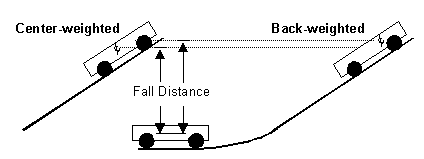 Figure 3 – Fall Distance Based on COG Position
Figure 3 – Fall Distance Based on COG PositionTesting The Track For Horizontal Cog
Testing for the best horizontal COG location for a given track is fairly easy if you have a track timer. Build a lightweight car without added weight, but with three dowel rod pieces sticking up out of the car (one in front, one in back, and one in the middle). Using steel washers weight the car in the front, back, and middle and compare the results. Mix and match to find the best COG for the track.
I ran time trials with this type of test car on a 32 foot ramp-flat track and found that rear-weighted cars outperformed front-weighted cars by up to one car length. Other testing results show similar results.
In addition, Michael Lastufka used a computer model to generate data and reached similar results at: www.lastufka.net/lab/cars/why/qplace.htm – 0.025 second improvement
Vertical COG – Up And Down
Let’s now move on to the vertical position of the weight. Is it better to have a high center of gravity (HCG) or a low center of gravity (LCG)? A LCG car will tend to be more stable, but it would seem that a HCG would impart more speed to the car. But is this really true?
In fact, it isn’t. Given two cars with the center of gravity at the same lengthwise location, but with one having the center of gravity low on the car, while the other has the center of gravity high on the car, the LCG car will fall a greater distance. Referring to Figure 4, note that because of the starting ramp angle, the fall distance for the HCG car is actually less than the fall distance of the LCG car. The actual difference is based on the slope angle. But on this hypothetical track, the HCG car falls only 96.6% of LCG car’s fall distance.
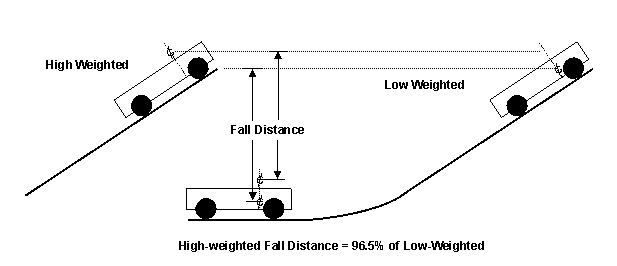 Figure 4 – Effect of Vertical Weight Position on Fall Distance
Figure 4 – Effect of Vertical Weight Position on Fall DistanceOther Considerations
Here are several other factors to consider when locating the weight
- Type of Weight – The actual weight type does not affect the speed of the car, but does affect how easily the COG can be placed as desired. Denser weight (such as tungsten) allows much greater flexibility in weight placement than does less dense weight (such as zinc).
- Length of Car – Longer cars allow the horizontal COG to be moved further to the rear (it also allows a longer wheelbase which aids in stability and alignment). So it is generally best to maintain the longest possible car body.
- Raised Wheel – A raised front wheel necessitates a rearward adjusted horizontal COG.
- Wheel Type – The horizontal COG must be measured with the wheels and axles installed. So, lighter wheels (such as our Outlaw Wheels) allow more flexibility in horizontal COG placement.
- Wheelbase – The location of the axles affects the location of the COG. Specifically, the position of the rear axle sets a limit on rearward placement of the horizontal COG. As noted in Figure 5, simply using the axle slot closest to the end of the block as the rear axle allows a 5/8 inch rearward movement of the horizontal COG.
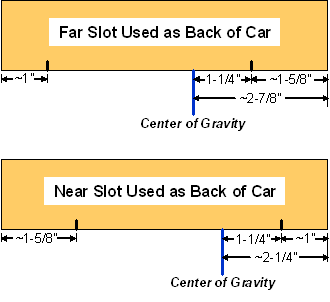 Figure 5 – Effect of Block Orientation on the Horizontal COG
Figure 5 – Effect of Block Orientation on the Horizontal COGConclusion
The COG has a significant effect on the performance of the car. If possible, find out the specifics of the target track and design your car for optimal performance.
Pinewood Derby Car Showcase
Mean Green Machine: Bob Babich
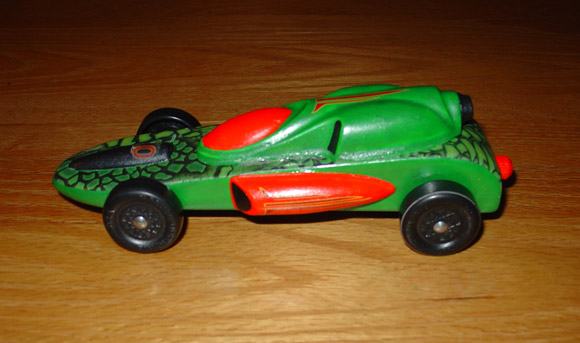
Flintstone Coupe: Scott Wheeler
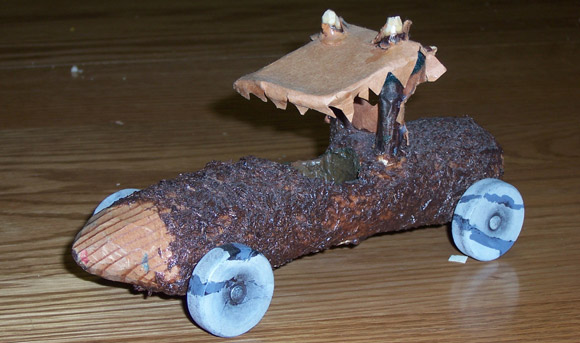
The wheels are standard BSA that have just been sanded down until all of the design is gone. I then painted them to look like stones with different shades of flat gray model paint.
After I showed it to the mother she said that maybe he could build one after all. Her son got some help from a neighbor and he did real well in the race if I correctly recall.
Dollar Car: Kevin & Kyle WhiteCorron
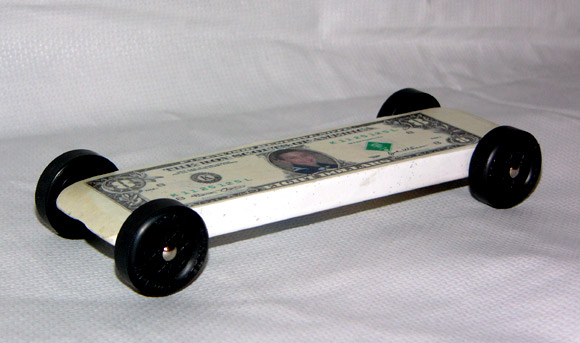
My son had always wanted to build a ‘dollar’ car,’ so we needed a flat car design to make it look like he wanted. We designed the dollar bill – which included his name and age – and we wanted the wheels to block the design as little as possible. The Extended Wing kit was perfect for the task, and it went together easily and quickly. The tungsten weights were a must to get the weight toward the rear. How did it do? It never lost a race.
Pinewood Derby Memory
90 Percent
I do a lot of hands-on work in the garage with my three sons around. Drilling, cutting, sanding. You name it, they have done it with my supervision. My oldest son (a Life Scout) never had the advantage of me using your site for tips when he was racing and never did better than 10th place in our Pack Pinewood Derby. But he did his best!
My 2nd son, now a 1st year Webelo, has taken 1st place at the Pack and 2nd place at the District two years in a row, with him doing 90 percent of the work. Being the Cubmaster I hear smart remarks about “his dad must be doing the work”. So this year I stressed to the parents that yes, my son has won 2 years in a row and all the information we used was found on the internet. You just have to look for it like I did!
So this year, like I always have, I asked my son, “Get a Hotwheels car that you like and we will try to duplicate it; but it still has to be your design.”
He responded back, “I already know I want a low flat car because they have less wind resistance!”. So I told him “The whole idea is to do your best and if you win that’s great!”
So we transferred the lines from the slots to the other side of the block, and marked the block for drilling holes (3 wheels to touch the ground). Then he drilled the holes with a drill press. I then laid out the weight placement for him to drill out. He then used my scroll saw to cut out the body, and then sanded it by hand. Next he chamfered the axle heads and removed the burrs. Then he sanded and polished the wheels.
Spray paint was next, followed by lubricating the wheels. Now I stepped back into the action and helped him install the wheels onto the car, and then align them. I thought to myself, “Yes he did 90 percent of the work.”
On race day he came home again taking 1st Place. After the race I said to him, “You know we even forgot to polish the axles! Next year why don’t we shoot for another category like best of show, or most original, and give someone else a chance to win the race?” He replied, “Yeah, let’s do it!”
Bill Whittaker
Q&A
I can never seem to get the paint to come out right. I can never get a good shine on the paint. It always look dull. What is the best way to apply paint?
The trick is to use a good quality paint, to apply multiple coats (lightly sanding between coats), and then finish with a clear coat. I recommend avoiding enamel paints, as they are a pain to work with.
I use Krylon brand paints (Michael’s Crafts and Ace Hardware carry this brand). Apply two coats of primer, then 2 or 3 coats of color, lightly sanding with 600 or 800 grit paper between coats. I then use Kylon “Crystal Clear” acrylic spray for the clear coat.
Another way to get a shine is to apply auto polish to the car body after painting. It will tend to shine up dull paint.
If you use a brand other than Krylon, make sure to check the dry and recoat times. Some paints have strange rules for recoating, and you don’t want to break them!
For even more information on painting, refer to the article “The Ultimate Finish”, in volume 3, issue 8.
Once I have primed, sanded, painted and re-sanded our car, will applying a car polish or wax to the body help with speed and reduce friction?
A clear coat generally works best. But as long as the product gives a nice hard, smooth finish, that doesn’t get soft or sticky when friction is applied, then it should be fine. This is important at the areas where the wheel hubs contact the car body. When the spinning wheels contact the area, the area heats up.
Car polishes are usually okay as they smooth the surface of the paint to improve the sheen. Waxes leave a layer of material that could soften with friction.
We just completed my son’s derby car using all of your great advice and products. I was wondering if you know what to use to remove excess graphite from the body without ruining the paint job?
I haven’t personally tried this, but several people have told me that you can put a little vegetable oil on a soft rag and wipe the car. Then go back over the car with a clean rag. For some reason, the vegetable oil picks up the graphite.
Want Answers?
Do you have a pinewood derby-related question? If so, e-mail us your question.We answer all questions by e-mail, but not every question will appear in the Q&A section of the newsletter.
Back Issues
Are you a new subscriber, or have you missed some of the previous newsletters? Don’t miss out; all of the issues for Volume 5 through Volume 17 are posted on our web site.
Newsletter Contributions
We welcome your contributions. If you would like to contribute an article, a web site review, a speed tip, or a pinewood derby memory, please e-mail us.
Subscription Information
The Pinewood Derby Times is a free e-newsletter focused on pinewood derby racing. It is published biweekly from October through March.
If you haven’t already done so, please forward this issue to your pinewood derby friends. But please don’t subscribe your friends. Let them decide for themselves. Thanks.
If this newsletter was forwarded to you, why not subscribe to receive this newsletter. There is no cost, and your e-mail address is safe, as we never sell or share our distribution list.
To subscribe, send a blank e-mail to
[email protected]
You will receive a confirmation e-mail. Reply to the confirmation e-mail and you will start receiving the Pinewood Derby Times with the next issue.
Randy Davis, Editor, Pinewood Derby Times
E-Mail: [email protected]
(C)2018, Maximum Velocity, Inc. All rights reserved. Please do not reprint or place this newsletter on your web site without explicit permission. However, if you like this newsletter we grant permission, and encourage you to e-mail it to a friend.
Maximum Velocity disclaims any personal loss or liability caused by utilization of any information presented in this newsletter.
The Pinewood Derby Times is not specific to, and is not affiliated with the Boy Scouts of America, YMCA, Awana, or any other organization.
(R)Maximum Velocity is a registered trademark of Maximum Velocity, Inc.
(R)Pinewood Derby is a registered trademarks of the Boys Scouts of America.
(R)Awana is a registered trademark of Awana Clubs International.
All other names are trademarks of their respective owners.
